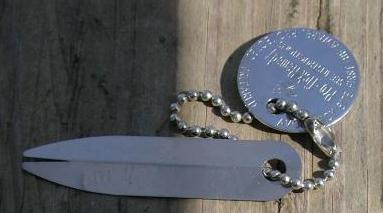| 4-25-05
A reader of this column and web page tells me about a Southern Indiana
mushroom hunt last week, but the gist of his story revolves around ticks,
mostly in the form of questions.
He had several questions. First, he was wondering what one could do
to keep ticks at bay while in tick-infested areas--just about any place
outdoors in Indiana. He also was concerned about procedures one should
follow to relieve itching sensations in areas of the skin where tick bites
occur, and what one should do if bitten by a tick.
My Southern Indiana upbringing and my propensities to spend time outdoors
often turned me into a flea bag when I was a kid, but in those days folks
didn’t worry a lot about this sort of thing. We picked them off, burned
them with heat from matches or the fire end of a cigarette and went about
our business.
Things changed. Along came Rocky Mountain Spotted Fever and Lyme disease,
and ticks became a whole new ballgame. The former can come from the bite
of the American dog tick or the lone star tick. The latter can be caused
only by the bite of the blacklegged tick.
My reader’s questions put me on the prowl for a brochure, “Ticks
and Disease In Indiana” that I have kept on my desk for some time.
Based on the work of Dr. Robert Pinger, THE AUTHORITY on ticks for nearly
20 years, and published by his employer, Ball State University, in cooperation
with the Department of Natural Resources and the Indiana Department of
Health, this beautiful piece of work is available free from any County
Public Health Office.
Although this brochure answered most of my questions concerning ticks
and their resulting maladies, I called Dr. Pinger at Ball State to be certain
the brochure still is available. Through my writing on the outdoors, I
had cooperated with Dr. Pinger’s tick projects for many years by encouraging
readers to send him ticks along with capture locations.
Dr. Pinger confirmed the availability of the brochure and suggested
that I check for more details with Dr. James F. Howell of the Indiana Department
of Health.
In addition to confirming the availability of the brochure through County
Health Offices, Dr. Howell pointed out that diseases caused by tick bites
are bacterial and can, thus, be treated by antibiotics. Dr. Howell also
said he knew of no deaths in recent years in Indiana that could be attributed
to tick diseases.
Although the three aforementioned ticks are most feared, Dr. Howell
and Dr. Pinger say Indiana hosts about 15 species of ticks, including the
brown dog tick. They added that while early spring to early summer is a
prime period for ticks, all of the three ticks may be present through the
warm months. They also said that although the blacklegged tick is often
thought to be a fall tick, it probably is present through the warm months.
It, of course, is most often hosted by deer. Contact by humans is more
likely during fall hunting seasons.
So how does one discourage ticks that are looking for a meal of blood
(which they must have to survive)? And what should one do if a tick is
found attached to one’s skin?
When I was growing up in Southern Indiana, rubbing the shoes and trouser
legs with a rag soaked in gasoline or kerosene was thought to be a good
deterrent for chiggers and ticks, but I am not so sure it worked.
I depended on feeling the little critters walking on my skin (usually
my legs), and picked them off and destroyed them. If a tick became attached
to my skin, I lightly removed it with fingernails and treated the minute
wounds with rubbing alcohol.
If bitten by a tick today, I would remove the tick and massage the area
of the bite with an antibiotic ointment.
Ticks tend to settle for lunch in hair-covered parts of the body, so
a check of such areas would be in order after exposure to tick-infested
outdoor areas.
Several years back, as a result of my occasional talks with Dr. Pinger,
I received a “Pro-Tick Remedy” called a “tick lifter.” It is made of light,
but rigid, metal (roughly two inches long and half an inch wide with a
tiny fork-like end--see picture). This little tool
is used to lift the attached tick from the skin gently to avoid leaving
the head embedded in the skin.
Although I had thought it was no longer available, I have just discovered
that this tool is still sold by REI, a distributor of camping equipment
and other outdoor items, and that one can order the “tick lifter” by mail,
e-mail, internet, or telephone (REI, PO Box 1700, Sumner, Washington 98352-0001;
phone, 1-800-426-4840; website, www.REI.com).
Partially opened cuticle or other small scissors
could also be used to gently encourage ticks to dislodge their barb-like
mouths from the skin.
In removing ticks, the watchwords are “slow and easy.” It is best not
to leave any part of the tick embedded in the skin. A gentle lifting pressure
is best. You don’t want to hurt the tick . . . you just want it to back
off . . . you can make the tick sorry it bit you later.
If bitten by a tick, there is no need to get excited, says Dr. Howell.
He adds that it is a good idea to keep an eye on the affected area. If
there is a reaction to the bite, or if the person bitten becomes ill, a
trip to a doctor would be advisable, he says.

|
This
is a photo of the Pro-Tick Remedy "tick lifter" I received several years
ago, still available from REI. (Partially opened cuticle or other small
scissors could also be used to gently encourage ticks to dislodge their
barb-like mouths from the skin.) |
|

